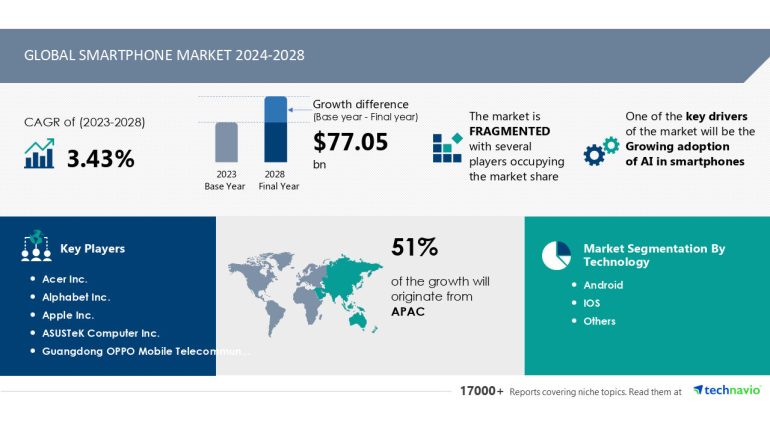- Global smartphone market to grow by USD 77.05 billion (2024-2028) at CAGR of over 3.43%, driven by AI adoption.
- Sensor fusion tech, like Bosch Sensortec’s FusionLib, enhances AR and navigation accuracy.
- Challenges include trade tensions affecting supply chains and semiconductor shortages.
- Market sees rapid evolution with 5G, advanced cameras, and robust app ecosystems.
- Future hinges on AI, sensor fusion, and 5G convergence for enhanced user experiences.
Main AI News:
The global smartphone market is projected to witness substantial growth, expanding by USD 77.05 billion from 2024 to 2028, achieving a compound annual growth rate (CAGR) exceeding 3.43%, according to a comprehensive analysis by Technavio. At the heart of this growth trajectory lies the accelerating integration of artificial intelligence (AI) technologies within smartphones, alongside significant advancements in sensor fusion technology.
AI integration is revolutionizing smartphone functionalities, empowering devices with capabilities such as voice recognition, image processing, and predictive analytics. This trend is pivotal in driving market expansion, as leading manufacturers such as Apple Inc., Samsung Electronics Co. Ltd., and Huawei Technologies Co. Ltd. leverage AI to differentiate their products in a fiercely competitive landscape.
Sensor fusion technology represents another critical innovation reshaping the smartphone market. Bosch Sensortec GmbH’s FusionLib, for instance, exemplifies this advancement by combining data from gyroscopes, geomagnetic sensors, and accelerometers to enhance accuracy in applications like augmented reality (AR) and GPS navigation. Such technologies are instrumental in meeting consumer expectations for seamless, reliable performance across diverse digital experiences.
However, the market faces challenges, primarily stemming from ongoing trade tensions impacting global supply chains. Tariffs and trade restrictions between major economies such as the US and China have escalated manufacturing costs, thereby affecting smartphone sales volumes and profitability. Additionally, semiconductor shortages have emerged as a significant bottleneck, impeding manufacturers’ ability to meet escalating consumer demand for advanced mobile technologies.
Despite these challenges, the smartphone market continues to evolve at a rapid pace, driven by innovations in 5G technology, enhanced camera functionalities, and a burgeoning ecosystem of mobile applications. Operating systems like Android and iOS remain central in shaping user experiences, underpinned by a dynamic developer community driving continuous innovation in mobile software solutions.
Looking ahead, the convergence of AI, sensor fusion technology, and 5G connectivity is poised to define the next phase of growth in the smartphone industry. As consumers increasingly rely on smartphones for productivity, entertainment, and connectivity, manufacturers and stakeholders alike must navigate regulatory landscapes and supply chain complexities to capitalize on emerging opportunities.
Conclusion:
The integration of AI technologies and sensor fusion into smartphones is set to drive substantial growth in the global market over the next few years. Despite challenges posed by trade tensions and semiconductor shortages, advancements in 5G connectivity, camera functionalities, and mobile applications continue to reshape consumer expectations and market dynamics. Stakeholders poised to leverage these innovations stand to capitalize on the increasing demand for intelligent, connected mobile devices that redefine digital experiences globally.

